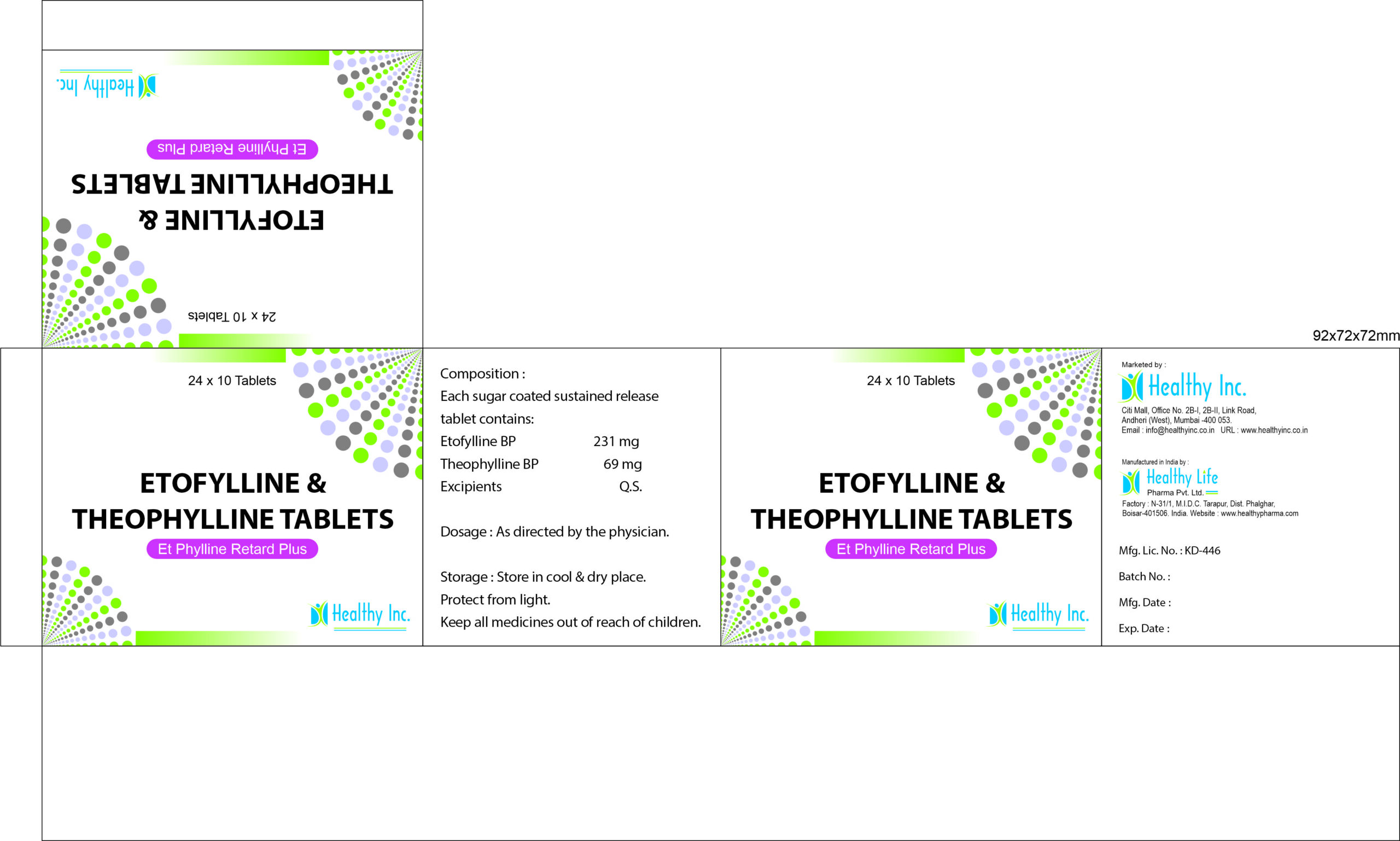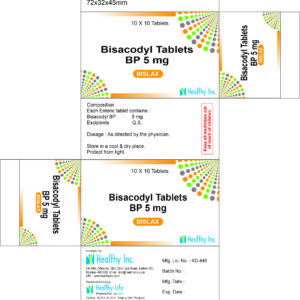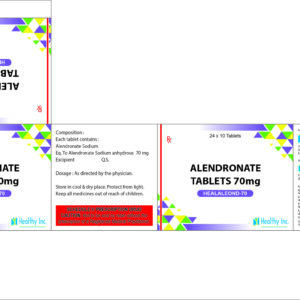Description
Product Description
Etofylline + Theophylline tablet
Healthy Incorporation and Healthy life pharma Pvt ltd are one of the leading manufacturer, supplier, and exporter of Etofylline + Theophylline tablets,in India and serving the world with best quality pharmaceutical products.
Etofylline + Theophylline tablet Manufacturer
Healthy incorporation and Healthy life pharma Pvt ltd, is Mumbai Based WHO GMP certified manufacturer of injection, tablets, capsules, liquid, dry syrups, pre-filled syringes, ointments etc. with an extensive experience of over 45 years in manufacturing and have reach in many countries. We offer this tablets in different strength & combinations as below.
Uses of Etofylline + Theophylline tablet:
Etofylline+Theophylline Tablet are used to cure, control, prevent, & improve the following diseases, conditions, and symptoms.
Difficulty in breathing
Asthma
Wheezing
Chest tightness
Shortness of breath
Chronic asthma
Breath shortness
Acute left ventricular failure
Interruption of breathing in newborns
It must be used on regular basis to prevent wheezing and shortness of breath. This medication belongs to a group of drugs known asxanthines. It does not work immediately and should not be used to relieve breathing problems quickly.
This tablet is available only on doctor prescription.
Additional Information of Etofylline + Theophylline tablets:
Product Name Etofylline + Theophylline tablets
Composition & Active ingredients Etofylline & Theophylline
Potency Available in different strength & combination
Therapeutic use Asthma/Lung problems
Packing 10 Tablets (1 Box)
Dosage As per Doctor Prescription
Precautions of Etofylline + Theophylline tablets:
Consult your doctor if you are pregnant or planning to get pregnant or breast-feeding mother.
Side Effects of Etofylline + Theophylline tablets:
Most of the time there is no serious side effects. Some common side effects may arise after starting medication, as your body adjusts to medicine.
Headache
Insomnia
Stomach pain
Fainting
Muscle cramps
Nausea
Vomiting
Confusion
Dizziness
Trouble in breathing
For Detailed Product Information Contact Us at +91 7710003340, If you need Any assistance in selecting our Products that fits your requirements. If you’re looking for any product that you’re not seeing here, please contact our support team.
Etofylline Theophylline tablets
Etofylline and theophylline are two medications often combined in tablet form to treat respiratory conditions such as asthma and chronic obstructive pulmonary disease (COPD). Here’s some information about each of these drugs and how they work together:
Theophylline: Theophylline is a bronchodilator that relaxes the muscles in the airways and improves airflow to the lungs. It belongs to a class of drugs called methylxanthines and is used to relieve symptoms of conditions like asthma and COPD. Theophylline also has anti-inflammatory properties that can help reduce airway inflammation.
Etofylline: Etofylline is a derivative of theophylline and works similarly to theophylline. It can also help relax the airway muscles and improve breathing.
When these two medications are combined in a tablet, it is often for the following reasons:
Enhanced therapeutic effect: The combination of etofylline and theophylline can offer a more significant bronchodilatory effect than either medication alone, making it more effective in managing respiratory conditions.
Reduced side effects: Lower doses of both medications can be used when they are combined, potentially reducing the risk of side effects associated with high doses of theophylline.
Stability: Combining these medications can also improve the stability of the formulation, making it easier to produce consistent and effective doses.
It’s important to note that this combination medication should be used under the guidance of a healthcare professional, as the dosing and use of etofylline and theophylline can vary based on the individual’s specific condition and needs. Additionally, regular monitoring of blood levels is often required to ensure the medications are at therapeutic levels and not causing adverse effects.
As with any medication, there can be side effects and potential drug interactions, so it’s essential to follow your healthcare provider’s recommendations and report any unusual symptoms or reactions while taking etofylline + theophylline tablets.
Etofylline and Theophylline are both medications used in the treatment of respiratory conditions, particularly asthma and chronic obstructive pulmonary disease (COPD). When combined in tablet form, they are typically prescribed to help manage these conditions. Let’s take a closer look at each component:
Theophylline: Theophylline is a bronchodilator and a methylxanthine derivative. It works by relaxing the smooth muscles in the airways, making it easier to breathe. Theophylline is used to treat conditions such as asthma and COPD. It helps to open up the air passages, reduce inflammation, and increase the flow of air into the lungs.
Etofylline: Etofylline is another methylxanthine compound. When used in combination with theophylline, it can enhance the bronchodilator effects and help manage respiratory conditions.
Combining etofylline and theophylline in a single tablet can be more convenient for patients and may provide a more effective treatment option for certain individuals. However, it is essential to take these medications as prescribed by a healthcare professional, as they have a narrow therapeutic range, meaning that the dosage must be carefully controlled to avoid potential side effects and toxicity.
Possible side effects of etofylline and theophylline may include nausea, vomiting, headache, increased heart rate, and nervousness. It’s crucial to follow your healthcare provider’s instructions and report any adverse effects or concerns while taking these medications.
Please note that specific formulations and brand names of medications may vary by country and manufacturer, so it’s essential to consult with a healthcare provider or pharmacist to get accurate and up-to-date information on the availability and usage of etofylline and theophylline tablets in your region.
Etofylline and theophylline tablets are a combination medication used to treat respiratory conditions such as asthma and chronic obstructive pulmonary disease (COPD). These tablets contain two active ingredients:
Theophylline: Theophylline is a bronchodilator medication that helps relax the muscles in the airways, making it easier to breathe. It is also thought to have anti-inflammatory properties and can improve the function of the respiratory system.
Etofylline: Etofylline is a derivative of theophylline and is often used in combination with theophylline to enhance its effectiveness. Etofylline can also help in widening the airways and improving respiratory function.
When taken together, these two medications can provide better control of symptoms in individuals with respiratory conditions. They work by relaxing the bronchial muscles, reducing inflammation, and increasing airflow to the lungs.
It’s important to note that these medications should only be used under the guidance and prescription of a healthcare professional, as they can have potential side effects and require careful monitoring of blood levels to ensure they are within the therapeutic range. The dosing and frequency of these tablets will be determined by your healthcare provider based on your specific condition and needs. Always follow your healthcare provider’s instructions and report any side effects or concerns while taking this medication.
Etofylline and Theophylline are medications commonly used to treat respiratory conditions, particularly asthma and chronic obstructive pulmonary disease (COPD). They are often combined in a single tablet to provide effective bronchodilation and improve lung function.
Theophylline: Theophylline is a bronchodilator that helps relax the muscles in the airways, making it easier to breathe. It also has anti-inflammatory effects. It is a xanthine derivative and is used in the treatment of asthma and COPD.
Etofylline: Etofylline is also a bronchodilator and belongs to the xanthine class of drugs. It is used to treat similar respiratory conditions and has properties that complement those of theophylline.
When combined in a tablet, Etofylline and Theophylline can have a synergistic effect in managing bronchial asthma, chronic bronchitis, and other obstructive airway diseases. The combination can improve lung function, reduce wheezing, and relieve shortness of breath.
It’s important to note that these medications can have side effects and should be used under the guidance of a healthcare professional. The dosage and frequency of use will depend on the specific condition being treated and individual patient factors. Additionally, drug formulations may vary by manufacturer and region, so it’s important to follow the prescribing information provided with the medication. If you have questions or concerns about these medications, it’s best to consult your healthcare provider for guidance.
Etofylline and Theophylline tablets are a combination medication used in the treatment of respiratory conditions, such as asthma and chronic obstructive pulmonary disease (COPD). These tablets contain two active ingredients:
Theophylline: Theophylline is a bronchodilator that relaxes the muscles in the airways and lungs, making it easier to breathe. It is often used to treat conditions characterized by bronchospasm, such as asthma and COPD.
Etofylline: Etofylline is a derivative of theophylline and has similar bronchodilator properties. It helps to open up the airways, reduce airway resistance, and improve breathing.
The combination of etofylline and theophylline can provide enhanced bronchodilation and better control of symptoms in some patients with respiratory conditions.
These tablets are typically prescribed by a healthcare professional, and the dosage and frequency of use will depend on the individual patient’s condition and response to the medication. It’s important to follow your doctor’s instructions and be aware of any potential side effects or interactions with other medications. Common side effects of these medications may include nausea, headache, and increased heart rate.
Please note that medication information can change over time, and it’s important to consult with a healthcare provider or pharmacist for the most up-to-date information on any specific medication, including etofylline and theophylline tablets.
Etofylline and Theophylline are medications commonly used to treat respiratory conditions such as asthma and chronic obstructive pulmonary disease (COPD). They are often combined into a single tablet to enhance their therapeutic effects. Here’s some information about these medications:
Theophylline: Theophylline is a bronchodilator and anti-inflammatory medication. It relaxes the smooth muscles in the airways, making it easier to breathe. Theophylline is also believed to have anti-inflammatory properties that can reduce airway inflammation. It’s often used as a long-term maintenance medication for individuals with chronic respiratory conditions.
Etofylline: Etofylline is another bronchodilator that works in a similar way to Theophylline. It helps open up the airways, making it easier for people with respiratory conditions to breathe.
Combining Etofylline and Theophylline in a single tablet can provide more effective symptom relief for people with asthma or COPD. It’s important to note that these medications must be used under the guidance of a healthcare professional, as they require careful dosing and monitoring due to potential side effects and interactions with other drugs.
Common side effects of Etofylline and Theophylline may include:
Nausea
Vomiting
Headache
Restlessness
Increased heart rate
Stomach upset
Patients taking these medications should have their blood levels of the drugs regularly monitored to ensure they are within the therapeutic range and to prevent toxicity.
If you or someone you know has been prescribed Etofylline and Theophylline tablets, it’s essential to follow the dosing instructions and any other guidance provided by a healthcare professional, as individual dosages and treatment plans can vary based on the specific condition and needs of the patient. Additionally, it’s important to report any side effects or concerns to the prescribing healthcare provider.
Etofylline and Theophylline are medications used to treat respiratory conditions, primarily asthma and chronic obstructive pulmonary disease (COPD). They are often combined in tablet form to provide more effective and convenient treatment for these respiratory disorders. Here’s some information about these two medications and their combination:
Theophylline: Theophylline is a bronchodilator and a member of the xanthine class of drugs. It works by relaxing the smooth muscles of the airways, which helps to open up the air passages in the lungs. This leads to improved airflow and easier breathing. Theophylline is used to manage and prevent symptoms in individuals with asthma and COPD. It can help reduce wheezing, shortness of breath, and other breathing difficulties.
Etofylline: Etofylline is another bronchodilator and anti-asthmatic agent. It acts in a similar way to theophylline, relaxing the airway muscles and improving airflow. Etofylline is often used in combination with theophylline to enhance the therapeutic effect while reducing the risk of side effects associated with higher doses of theophylline.
The combination of Etofylline and Theophylline in tablet form is used to achieve better control over respiratory symptoms and to reduce the frequency and severity of asthma or COPD exacerbations. Theophylline levels in the blood can vary among individuals, and using this combination allows for more stable and predictable blood levels.
It’s essential to use this medication as prescribed by your healthcare provider, as dosages and administration schedules can vary based on your specific condition and medical history. Additionally, both Etofylline and Theophylline can have potential side effects and interactions with other medications, so it’s important to discuss any concerns with your healthcare provider or pharmacist.
Common side effects of these medications may include nausea, vomiting, headache, and nervousness. If you experience severe side effects, such as rapid heartbeat, chest pain, or seizures, seek immediate medical attention.
This information is intended for general knowledge, and it’s important to consult a healthcare professional for personalized advice and treatment recommendations specific to your condition.
Etofylline and Theophylline tablets are a combination medication used to treat respiratory conditions such as asthma and chronic obstructive pulmonary disease (COPD). These tablets typically contain two active ingredients:
Etofylline: Etofylline is a bronchodilator and anti-inflammatory agent. It helps to relax the muscles in the airways, making it easier to breathe. It also reduces inflammation in the airways, which can help alleviate symptoms of respiratory conditions.
Theophylline: Theophylline is another bronchodilator that works by relaxing the smooth muscles in the airways and improving airflow to the lungs. It also has anti-inflammatory properties and can help reduce airway inflammation.
The combination of these two medications can provide more effective relief for individuals with asthma or COPD than using them separately. These tablets are typically taken orally as directed by a healthcare professional.
It’s essential to follow your doctor’s instructions regarding the dosage and usage of Etofylline and Theophylline tablets, as these medications can have potential side effects and interactions with other drugs. Additionally, you should inform your healthcare provider of any other medications you may be taking to ensure there are no adverse interactions.
Etofylline and Theophylline are two drugs commonly used in combination to treat respiratory conditions, particularly in the management of asthma and chronic obstructive pulmonary disease (COPD). These medications work by relaxing the muscles in the airways and reducing inflammation, making it easier to breathe. Here’s a brief overview of each drug:
Theophylline: Theophylline is a bronchodilator that helps relax the smooth muscles in the airways, making it easier to breathe. It also has anti-inflammatory properties. Theophylline can be taken orally, and it’s used in the long-term management of asthma and COPD.
Etofylline: Etofylline is a xanthine derivative that’s often combined with Theophylline in medications. It helps improve the solubility and bioavailability of Theophylline. This combination can lead to more consistent drug levels in the body and reduce the risk of side effects.
The combination of Etofylline and Theophylline in tablet form is used to provide a more effective and convenient treatment option for individuals with respiratory conditions. These tablets are typically taken by mouth on a regular schedule as prescribed by a healthcare provider. It’s essential to follow the dosing instructions provided by your doctor and to be aware of any potential side effects or drug interactions, as both Etofylline and Theophylline can have specific adverse effects and interactions with other medications.
As with any prescription medication, it’s crucial to consult your healthcare provider for a complete understanding of how this combination medication works, its potential side effects, and how to take it correctly. Additionally, your doctor will tailor the treatment to your specific needs and medical history, so it’s important to communicate any concerns or questions you may have about the medication with them.
Etofylline and theophylline are both bronchodilators used to treat various respiratory conditions, particularly asthma and chronic obstructive pulmonary disease (COPD). They work by relaxing the muscles in the airways, which helps improve breathing and alleviate symptoms like wheezing, shortness of breath, and coughing.
Combining etofylline and theophylline in a single tablet is a common practice in the pharmaceutical industry. This combination serves multiple purposes, including:
Synergy: Etofylline and theophylline can work together to provide a stronger bronchodilatory effect when combined than when used individually. This synergy allows for lower doses of each drug, potentially reducing side effects.
Extended release: Some formulations of these tablets are designed to release the medication gradually over time, ensuring a consistent and prolonged effect. This can help in managing respiratory conditions with fewer dosing intervals.
Convenience: Combining two medications into a single tablet simplifies the dosing regimen, making it easier for patients to adhere to their treatment plans.
It’s essential to follow your healthcare provider’s instructions and dosing recommendations when using etofylline and theophylline tablets, as the appropriate dosage can vary based on your specific condition and medical history. Additionally, be aware of potential side effects and drug interactions, as these medications can have adverse effects or interact with other drugs you may be taking. Always consult your healthcare professional for personalized guidance and to monitor your progress when using these medications.
Note: Healthy Incorporation and Healthy life pharma Pvt ltd tries to ensure that all information, whether in relation to the products, services, offerings provided as part of this website is correct at the time of inclusion on the website, Unauthorized use of any materials contained on this website may violate copyright laws, trademark laws, the laws of privacy and publicity, certain communications statutes and regulations and other applicable laws and regulations. All copyright and other intellectual property rights in this material are owned by Healthy Incorporation and Healthy life pharma Pvt ltd. Please connect with us to discuss precise product specifications and requirements and obtain advice on which products are suitable for your requirement or you can write to us
Etofylline + Theophylline Combination , एटोफ़िलाइन + थियोफ़िलाइन संयोजन, Combinación de etofilina + teofilina, Combinaison étofylline + théophylline , إيتوفيلين + تركيبة ثيوفيلين , 依托茶鹼 + 茶鹼組合 , Combinação Etofilina + Teofilina , Комбинация этофиллина + теофиллина , エトフィリン + テオフィリンの組み合わせ , suppliers India, Exporters,Wholesalers India, Distributors India, Generic Supplier,who gmp certified manufacturer








